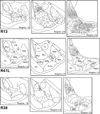GABAergic somatostatin-immunoreactive neurons in the amygdala project to the entorhinal cortex
- PMID: 25637800
- PMCID: PMC4586050
- DOI: 10.1016/j.neuroscience.2015.01.028
GABAergic somatostatin-immunoreactive neurons in the amygdala project to the entorhinal cortex
Abstract
The entorhinal cortex and other hippocampal and parahippocampal cortices are interconnected by a small number of GABAergic nonpyramidal neurons in addition to glutamatergic pyramidal cells. Since the cortical and basolateral amygdalar nuclei have cortex-like cell types and have robust projections to the entorhinal cortex, we hypothesized that a small number of amygdalar GABAergic nonpyramidal neurons might participate in amygdalo-entorhinal projections. To test this hypothesis we combined Fluorogold (FG) retrograde tract tracing with immunohistochemistry for the amygdalar nonpyramidal cell markers glutamic acid decarboxylase (GAD), parvalbumin (PV), somatostatin (SOM), neuropeptide Y (NPY), vasoactive intestinal peptide (VIP), and the m2 muscarinic cholinergic receptor (M2R). Injections of FG into the rat entorhinal cortex labeled numerous neurons that were mainly located in the cortical and basolateral nuclei of the amygdala. Although most of these amygdalar FG+ neurons labeled by entorhinal injections were large pyramidal cells, 1-5% were smaller long-range nonpyramidal neurons (LRNP neurons) that expressed SOM, or both SOM and NPY. No amygdalar FG+ neurons in these cases were PV+ or VIP+. Cell counts revealed that LRNP neurons labeled by injections into the entorhinal cortex constituted about 10-20% of the total SOM+ population, and 20-40% of the total NPY population in portions of the lateral amygdalar nucleus that exhibited a high density of FG+ neurons. Sixty-two percent of amygdalar FG+/SOM+ neurons were GAD+, and 51% were M2R+. Since GABAergic projection neurons typically have low perikaryal levels of GABAergic markers, it is actually possible that most or all of the amygdalar LRNP neurons are GABAergic. Like GABAergic LRNP neurons in hippocampal/parahippocampal regions, amygdalar LRNP neurons that project to the entorhinal cortex are most likely involved in synchronizing oscillatory activity between the two regions. These oscillations could entrain synchronous firing of amygdalar and entorhinal pyramidal neurons, thus facilitating functional interactions between them, including synaptic plasticity.
Keywords: entorhinal cortex; long-range GABAergic neurons; nonpyramidal neurons; parasubiculum; prefrontal cortex; retrograde tract tracing.
Copyright © 2015 IBRO. Published by Elsevier Ltd. All rights reserved.
Figures










References
-
- Beckstead RM. Afferent connections of the entorhinal area in the rat as demonstrated by retrograde cell-labeling with horseradish peroxidase. Brain Res. 1978;152:249–264. - PubMed
-
- Buzsáki G, Chrobak JJ. Temporal structure in spatially organized neuronal ensembles: a role for interneuronal networks. Curr Opin Neurobiol. 1995;5:504–510. - PubMed
-
- Canteras NS, Simerly RB, Swanson LW. Connections of the posterior nucleus of the amygdala. J Comp Neurol. 1992;324:143–179. - PubMed
Publication types
MeSH terms
Substances
Grants and funding
LinkOut - more resources
Full Text Sources
Other Literature Sources
Miscellaneous

